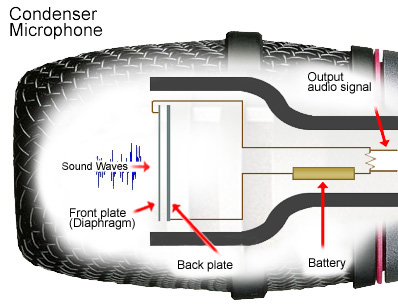condenser microphone

A condenser microphone is a microphone that generates an electrical signal when sound waves vary the spacing between two charged surfaces, specifically the diaphragm (front plate) and the back plate. Condenser microphones offer the greatest fidelity in terms of transducing sound waves into an electrical signal. Compare with dynamic microphone.
Power supply
As the plates of the capacitor need to be kept charged while the mic is in use (an exception to this is the "electret condenser"), an external source of power is required. This is usually a DC supply of up to 48 volts, which is also known as phantom power, as the power is carried through the same cable as the audio signal. There are some condenser mics, such as the AKG C1000S, that use a battery instead, and these types are known as back-electrets.
Condenser microphones in use
Condenser mics are also highly sensitive to picking up hums, ground loops, etc, and have a delicacy which renders many of them more suitable for studio, rather than stage use. Even then, many of them have to be used in conjunction with a special cradle, called a shock mount) which inhibits interference from external sources. However, there is no substitute for the fidelity, high-end detail, and beauty of sound rendered by a "large-plate" condenser microphone. They are the first-choice for recording acoustic guitar and vocals, but they can also be used to get a clear, glassy tone on clean amps, or a warmer, grainy tone on distorted amps. They may also have pads – switches enabling them to record high-volume sources, such as a cranked-up Marshall stack, without distorting.


